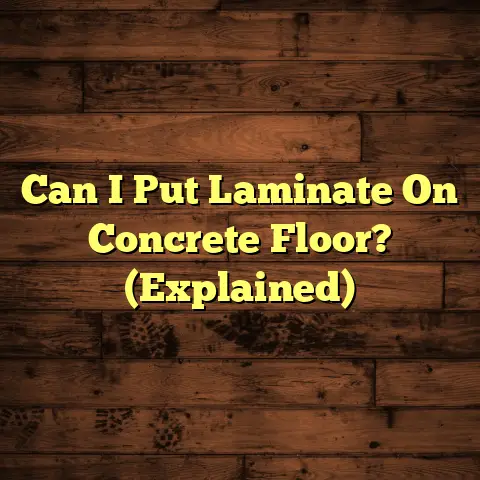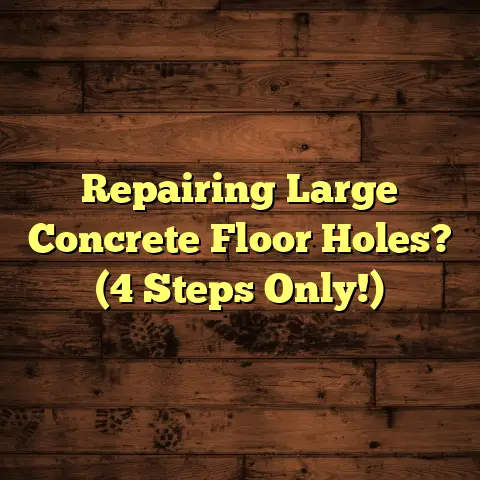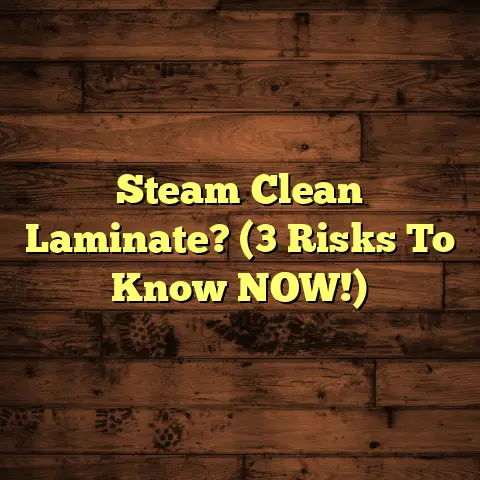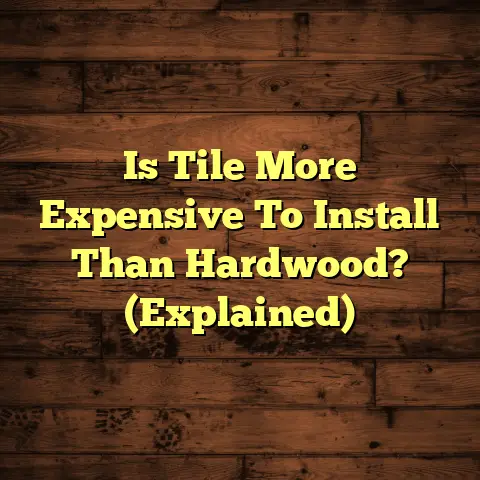Vinyl Under Stove? Read This! (3 Risks!)
I’m a flooring contractor, and I’ve seen it all when it comes to kitchen renovations.
One of the biggest investments you’ll make in your home is your kitchen.
It’s not just about how it looks, but also how well it functions and holds up over time.
Flooring plays a HUGE part in that.
We all want a kitchen that’s beautiful, durable, and easy to clean.
That’s why vinyl flooring has become so popular.
It’s affordable, comes in tons of styles, and seems pretty low-maintenance, right?
But before you jump on the vinyl bandwagon, especially if you’re thinking about putting it under your stove, there are some things you REALLY need to know.
Think of your kitchen floor as an investment.
The right choice can add value to your home and make it more appealing to potential buyers down the road.
But the wrong choice?
Well, let’s just say it can lead to headaches and costly repairs.
While vinyl flooring can be a fantastic choice for kitchens, especially given its water resistance and style options, there are specific risks associated with putting it under your stove.
And trust me, you don’t want to learn about these the hard way.
So, what are these risks?
Buckle up; I’m about to spill the beans.
Understanding Vinyl Flooring
Let’s start with the basics: what is vinyl flooring, anyway?
Basically, it’s a synthetic flooring material made from polyvinyl chloride (PVC) and other compounds.
You’ll find it in a few different forms:
- Luxury Vinyl Plank (LVP): This looks like wood and comes in planks.
- Luxury Vinyl Tile (LVT): This mimics tile and comes in squares.
- Sheet Vinyl: This comes in large rolls and is good for covering large areas.
One of the biggest reasons vinyl is so popular is its versatility.
It can mimic the look of hardwood, tile, or even stone, without the hefty price tag.
Plus, it’s water-resistant, easy to install, and comes in a HUGE range of styles and colors.
That’s why you see it popping up in more and more kitchen renovations.
According to recent industry reports, vinyl flooring has seen a significant increase in popularity in kitchens over the past decade.
I’ve personally seen a surge in homeowners requesting it.
It’s easy to see why.
It can handle spills, is comfortable underfoot, and looks great.
But here’s where things get tricky.
While vinyl is great for many areas of the kitchen, putting it under a stove introduces some unique challenges.
These challenges are often overlooked in the initial excitement of a kitchen makeover.
And that’s where I come in.
I want to make sure you’re armed with the knowledge to make the best decision for your kitchen.
Risk #1 – Heat Damage
Okay, let’s get to the first big risk: heat damage.
Stoves get HOT.
Whether you have an electric, gas, or induction stove, they all generate a significant amount of heat.
And that heat can wreak havoc on vinyl flooring.
Think about it: vinyl is a plastic-based material.
What happens to plastic when it gets too hot?
It can warp, melt, and even discolor.
The heat from your stove can radiate downwards, especially if you have an older model or one that’s not properly insulated.
This can cause the vinyl flooring underneath to soften and become distorted.
I’ve seen it happen firsthand.
I remember one client who had installed a beautiful new LVP floor in her kitchen.
Within a few months, she noticed that the planks directly under her stove were starting to bubble and peel.
The heat from the oven had caused the adhesive to fail, and the vinyl was literally coming apart.
Another client had sheet vinyl under their stove, and it became discolored and brittle over time due to the constant heat exposure.
It looked awful and had to be replaced.
Now, you might be thinking, “Okay, but my stove doesn’t get that hot on the bottom.”
And maybe you’re right.
But even if the heat isn’t intense enough to cause immediate damage, prolonged exposure can still take its toll.
Over time, the vinyl can become more susceptible to scratches, dents, and other types of wear and tear.
So, what can you do to mitigate this risk?
Well, the truth is, there’s no foolproof way to completely eliminate the risk of heat damage.
Placing vinyl under a stove inherently exposes it to heat.
However, there are some preventative measures you can take.
One option is to use a heat shield or a stove mat.
These are designed to deflect heat away from the floor and can provide an extra layer of protection.
You can find these at most appliance stores or online.
Another thing to consider is the type of stove you have.
Electric stoves tend to generate more radiant heat than gas stoves, so if you have an electric stove, you might want to be extra cautious.
Induction stoves, on the other hand, generate heat directly in the cookware, so they might be a slightly safer option.
Regardless of what type of stove you have, it’s always a good idea to check the manufacturer’s instructions for any specific recommendations regarding flooring.
They might have guidelines on the type of flooring that’s safe to use with their appliances.
Ultimately, the best way to prevent heat damage is to avoid putting vinyl flooring directly under your stove altogether.
Consider using a different type of flooring in that area, such as tile or a heat-resistant mat.
It might not be the most aesthetically pleasing solution, but it could save you a lot of headaches in the long run.
Risk #2 – Moisture and Spillage
Alright, let’s move on to the second major risk: moisture and spillage.
The kitchen is a wet and wild place.
Spills happen.
Pots boil over.
Dishes get splashed.
And all that moisture can wreak havoc on your vinyl flooring, especially under your stove.
Think about it: when you’re cooking, things inevitably end up on the floor.
Whether it’s a splash of sauce, a dribble of oil, or a rogue piece of pasta, that stuff can seep under your stove and get trapped between the vinyl flooring and the subfloor.
And that’s where the problems start.
Moisture trapped under vinyl flooring can create the perfect breeding ground for mold and mildew.
These nasty organisms can not only damage your flooring but also pose a health risk to you and your family.
Mold can cause respiratory problems, allergies, and other health issues.
And once it gets a foothold, it can be tough to get rid of.
I’ve seen cases where homeowners had to completely rip up their vinyl flooring and replace the subfloor due to severe mold infestations.
It’s a costly and unpleasant experience that no one wants to go through.
But mold isn’t the only concern.
Moisture can also cause the adhesive that holds the vinyl flooring in place to weaken and fail.
This can lead to bubbles, peeling, and other types of damage.
And if the moisture gets bad enough, it can even cause the subfloor to rot.
I remember one homeowner who had a leaky dishwasher that wasn’t properly sealed.
Water would seep out every time she ran the dishwasher, and it would eventually find its way under her stove.
Over time, the moisture caused the vinyl flooring to lift and peel, and the subfloor underneath started to rot.
She ended up having to replace the entire floor and repair the subfloor, which cost her thousands of dollars.
Another common scenario is when homeowners mop their kitchen floors.
If you’re not careful, water can seep under the stove and get trapped.
Even if you wipe it up right away, some moisture can still linger and cause problems over time.
So, what can you do to protect your vinyl flooring from moisture and spills?
Well, the first step is to be extra vigilant about cleaning up spills as soon as they happen.
Don’t let liquids sit on the floor for any length of time.
Use a damp cloth or mop to wipe up spills, and make sure to dry the area thoroughly.
You might also want to consider using a sealant around the edges of your stove to prevent liquids from seeping underneath.
There are special sealants designed for this purpose that you can find at most home improvement stores.
Another important thing to do is to regularly inspect your appliances for leaks.
Check your dishwasher, refrigerator, and stove for any signs of water damage.
If you spot a leak, get it fixed right away to prevent further damage.
When you’re mopping your kitchen floor, be careful not to use too much water.
Use a damp mop instead of a soaking wet one, and make sure to wring it out thoroughly before you start mopping.
You might also want to consider using a steam mop, which uses hot steam to clean the floor without leaving behind a lot of moisture.
Ultimately, the best way to protect your vinyl flooring from moisture and spills is to be proactive and take preventative measures.
By being careful and diligent, you can minimize the risk of water damage and keep your kitchen floor looking great for years to come.
Risk #3 – Difficulties in Maintenance and Repair
Okay, let’s talk about the third risk: difficulties in maintenance and repair.
Having vinyl flooring under your stove can make cleaning and fixing things a real pain.
Think about it: stoves are heavy.
Really heavy.
Trying to move one to clean underneath or make repairs is not easy.
And that’s where the problems start.
Cleaning under the stove can be a real challenge.
Crumbs, spills, and other debris can accumulate under there, creating a breeding ground for bacteria and pests.
But how do you get under there to clean it?
You can’t just sweep or mop under the stove without moving it.
And moving a stove is not a one-person job.
You’ll need help, and you’ll need to be careful not to damage the floor or the stove itself.
Even if you manage to move the stove, cleaning under it can still be difficult.
You might need to use special tools or cleaning solutions to get rid of stubborn stains or grime.
And if you have pets, you might find pet hair and dander accumulating under the stove, which can be difficult to remove.
But cleaning is just one part of the problem.
What happens if you need to repair the vinyl flooring under your stove?
Maybe a section of the flooring is damaged, or maybe you need to replace it altogether.
Either way, you’re going to have to move the stove.
And that can be a major headache.
I remember one homeowner who had a small section of vinyl flooring under their stove that was damaged by a dropped pot.
They tried to repair it themselves, but they couldn’t get the stove out of the way without damaging the surrounding flooring.
They ended up having to hire a professional to move the stove and repair the flooring, which cost them a lot of money.
Another common scenario is when homeowners need to replace their stove.
If the vinyl flooring under the old stove is damaged or worn, they might want to replace it at the same time.
But that means moving the old stove and the new stove, which can be a real challenge.
And if the vinyl flooring is glued down, it can be difficult to remove without damaging the subfloor.
So, what can you do to make maintenance and repair easier?
Well, the first step is to keep the area around your stove as clean as possible.
Wipe up spills right away, and sweep or vacuum regularly to remove crumbs and debris.
You might also want to consider using a stove gap cover to prevent food and liquids from falling between the stove and the countertop.
These are inexpensive and easy to install, and they can save you a lot of cleaning time.
When you’re cleaning under the stove, use a vacuum cleaner with a hose attachment to reach into tight spaces.
You might also want to use a long-handled brush or mop to clean the floor without having to move the stove.
If you need to move the stove, be sure to get help from someone else.
Don’t try to move it by yourself, as you could injure yourself or damage the floor.
Before you move the stove, disconnect the power or gas supply.
This is important for safety reasons.
You should also protect the surrounding flooring with blankets or cardboard to prevent scratches or dents.
If you’re replacing the vinyl flooring, consider using a floating floor system instead of gluing it down.
Floating floors are easier to install and remove, and they won’t damage the subfloor.
You might also want to consider using individual vinyl tiles or planks instead of sheet vinyl.
These are easier to replace if they get damaged, and you won’t have to replace the entire floor.
Ultimately, the best way to make maintenance and repair easier is to plan ahead and take preventative measures.
By keeping the area around your stove clean and protected, you can minimize the risk of damage and make cleaning and repairs a lot easier.
Conclusion
So, there you have it: the three primary risks associated with having vinyl flooring under your stove:
- Heat Damage: Stoves get hot, and that heat can warp, melt, and discolor vinyl flooring.
- Moisture Issues: Spills and leaks can get trapped under the stove, leading to mold, mildew, and damage to the subfloor.
- Maintenance Challenges: Moving a heavy stove for cleaning or repairs is difficult and can lead to further damage.
Now, I’m not saying that you should never put vinyl flooring under your stove.
Many people do it, and it works out just fine.
But it’s important to be aware of the risks and take steps to mitigate them.
Before you make a final decision, take a good hard look at your cooking habits, your appliances, and your overall kitchen layout.
Do you cook a lot?
Do you tend to be messy in the kitchen?
Do you have a newer, well-insulated stove, or an older model that tends to run hot?
These are all important factors to consider.
And remember, there are other flooring options out there.
Tile, for example, is much more heat-resistant than vinyl, and it’s also easier to clean.
It might be a better choice for the area directly under your stove.
Ultimately, the decision is yours.
But I hope this article has given you the information you need to make an informed choice about your kitchen investment.
Happy renovating!





